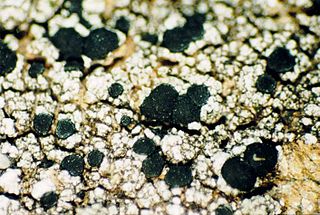
The Lecanoraceae are a family of lichenized fungi in the order Lecanorales. Species of this family have a widespread distribution.
Thelocarpon is a genus of fungi in the family Thelocarpaceae.

Lecidella is a genus of crustose lichens in the family Lecanoraceae.

Miriquidica is a genus of lichen in the family Lecanoraceae. The genus was circumscribed in 1987 by lichenologists Hannes Hertel and Gerhard Rambold, with Miriquidica complanata assigned as the type species. According to Dictionary of the Fungi, the widespread genus contains 23 species, found predominantly in arctic-alpine regions.

Porpidia is a genus of crustose lichens in the family Lecideaceae.

Rhizocarpon is a genus of crustose, saxicolous, lecideoid lichens in the family Rhizocarpaceae. The genus is common in arctic-alpine environments, but also occurs throughout temperate, subtropical, and even tropical regions. They are commonly known as map lichens because of the prothallus forming border-like bands between colonies in some species, like the common map lichen.

Fuscidea is a genus of crustose lichens in the family Fuscideaceae. It has about 40 species. The genus was circumscribed in 1972 by lichenologists Volkmar Wirth and Antonín Vězda, with Fuscidea aggregatilis assigned as the type species.

Nesolechia is a genus of parasitic fungi in the family Parmeliaceae. All three species in the genus grow on lichens. Nesolechia probably evolved from a lichen ancestor, as it is closely related to many lichenized species of fungi.

Phacopsis is a genus of lichenicolous (lichen-dwelling) fungi. They are parasites of members of the large lichen family Parmeliaceae, of which they are also a member. Originally proposed by Edmond Tulasne in 1852 to contain 3 species, Phacopsis now contains 10 species, although historically, 33 taxa have been described in the genus. Many of the species are poorly known, some of them having been documented only from the type specimen.

Catillaria is a genus of crustose lichens in the family Catillariaceae. The genus was circumscribed by Italian lichenologist Abramo Bartolommeo Massalongo in 1852. It is the type genus of Catillariaceae, which was circumscribed by Austrian lichenologist Josef Hafellner in 1984.

Carbonea vitellaria is a species of lichenicolous fungus belonging to the family Lecanoraceae. It has a worldwide distribution. In Iceland it has been reported growing on Candelariella vitellina near Egilsstaðir and on King George Island, Antarctica.

Sclerococcum is a genus of lichenicolous fungi in the family Dactylosporaceae.

Muellerella pygmaea is a species of lichenicolous fungus in the family Verrucariaceae. It has a cosmopolitan distribution in Arctic-alpine areas and grows on the thallus and apothecia of a number of hosts.
Hannes Hertel is a German botanist and taxonomist and was Director of the State Herbarium in Munich, Germany 1992 - 2004. His specialist areas are the fungi and lichens.
Carbonea assentiens is a species of lichen belonging to the family Lecanoraceae. It is found in Antarctica and in the islands of the subantarctic.
Carbonea aggregantula is a species of lichen belonging to the family Lecanoraceae.












